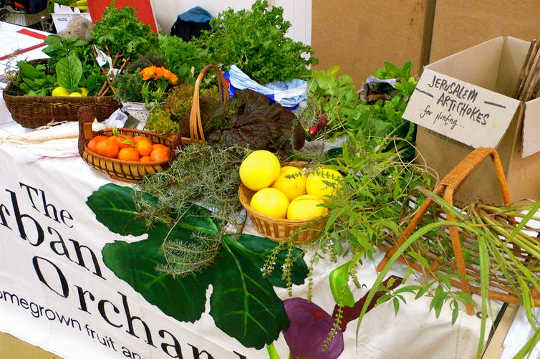
If we tend to the local food industry, we could reap the harvest. donkeycart/Flickr, CC BY-NC
While Australia’s national food and agriculture debate centres on boosting production and increasing exports, our local food industry is being neglected. That’s a shame because countries such as the United States and Canada, which have explicitly prioritised local food, are now reaping the economic benefits.
A few weeks ago, the federal government decided to scrap the A$1.5 million Community Food Grants program.
This meant that 364 community gardens, farmers’ markets, food rescue organisations, community kitchens and other groups - more than 200 of whom had already been approved for grants up to A$20,000 - were informed that the program would be wound up and no funds disbursed due to the “tight fiscal environment”.
The grants were originally part of the now-defunct National Food Plan, a key Labor initiative launched in May 2013.
The food bowl myth
It has been said that a “dining boom” awaits our farmers and food manufacturers, brought about by the swelling ranks of the Asian middle classes who are demanding our agricultural commodities.
This is the thinking that informs the federal government’s White Paper on Agriculture, which is calling for submissions until April 17.
But its primary motivation has nothing to do with “feeding the world”, although that provides an ideological fig-leaf. Rather, bipartisan food and agricultural policy in this country is above all about meeting corporate hunger for profit.
What is lost in this myopic drive for growth and profit are the many other dimensions and functions of our food and agricultural systems, including local food systems.
The United States: local food makes economic sense
Overseas, things are done a little differently.
For more than 20 years, the US Department of Agriculture (USDA) has made tens of millions of dollars available in grants and low-interest loans to the local food sector. Here are some of the results of the return on this public investment:
* The numbers of farmers’ markets in the US rose from 340 in 1970 to 8144 in 2013.
* In 1997-8 there were two farm-to-school programs; now there are over 2000 ; and 46 states have either enacted or proposed legislation to support farm-to-school programs in their jurisdiction.
* Over 200 Food Hubs now exist across the country from under ten a few years ago, providing distribution and marketing solutions at scale for many farmers and businesses.
* Total local food sales reached US$4.8 billion in 2008/9, with US$1.2 billion being direct-to-consumer sales.
The USDA’s own economists explain the solid economic case:
“Fruit and vegetable farms selling into local and regional markets employ 13 full-time workers per US$1 million in revenue earned… In comparison, fruit and vegetable farms not engaged in local food sales employed three full-time workers per US$1 million in revenue.”
This translates into local food economy job-creation rates being three times higher than national and/or global food economies.
In terms of the multiplier effect, studies suggest that the percentage of money spent in local businesses that is retained in the local economy is typically more than 50%, compared with only 15-30% of money spent in non-local businesses.
In Illinois, according to a 2009 local food report, a 20% increase in local food production will generate US$20 billion to US$30 billion of new economic activity, resulting in thousands of new jobs.
Applying the same logic across all Australian states (with a total combined annual spend on food of US$158 billion, compared with US$48 billion in Illinois) would mean that the same 20% shift to local food in Australia would lead to at least A$50 billion of new economic activity, with consequent major job-creation and local business impacts.
Compare that figure with food imports, which in 2010 reached A$10.6 billion, a near-tripling since 1991.
I haven’t even touched on the non-economic benefits of local food: the increased consumption of fruit and vegetables, the reduced environmental impact, and the enhanced social capital.
Canada: local food and the law
It’s for all these reasons that Canada is following the same path. The Local Food Act passed the Ontario Provincial legislature last year with unanimous, bipartisan support.
In Ontario, and throughout much of Canada, local food is non-contentious. Every political party supports it, as does Walmart Canada, Cisco and other multinational food service providers, hospitals, schools, chefs, farmers and local communities.
It’s no longer a political issue: it’s just good, common sense. As the preamble to the Act acknowledges:
“The variety of food produced, harvested and made in Ontario reflects the diversity of its people. This variety is something to be celebrated, cherished and supported. Strong local and regional food systems deliver economic benefits and build strong communities”.
The Local Food Act mandates the Minister of Agriculture and Food to set goals or targets with respect to:
* Improving food literacy in respect of local food
* Encouraging increased use of local food by public sector organisations
* Increasing access to local food
The Local Food Act also creates a 25% tax credit for farmers who donate produce to local food banks, directly improving their bottom line while getting more good food to those who need it. With food relief agencies in Australia experiencing unprecedented levels of demand, this is also a major opportunity and need.
Another plank of the Canadian strategy is a dedicated Local Food Fund, worth up to C$30 million over three years to support innovative projects that enhance the purchase of local food and contribute to economic development.
Expanding local food
In Australia, local government has begun to analyse the benefits of a bigger local food industry. Victoria’s Mornington Peninsula Shire found in preliminary modelling that expanding its local food industry by 5% would bring in A$15 million and create nearly 200 jobs.
This is an invitation to any politician or political party with the courage to expand this thinking to state and national scale. It doesn’t have to be either exports or just local food: it can be both. If the US and Canada can do it, so can we.
There’s never been a better time.![]()
About The Author
Nick Rose, Research Fellow, Deakin University
This article is republished from The Conversation under a Creative Commons license. Read the original article.
Related Books
at InnerSelf Market and Amazon























